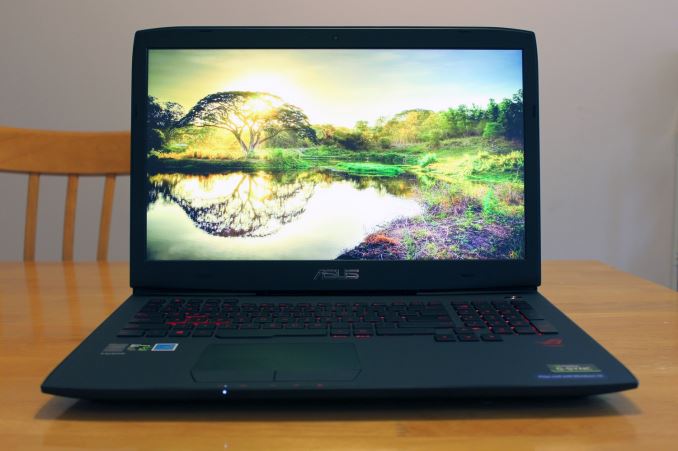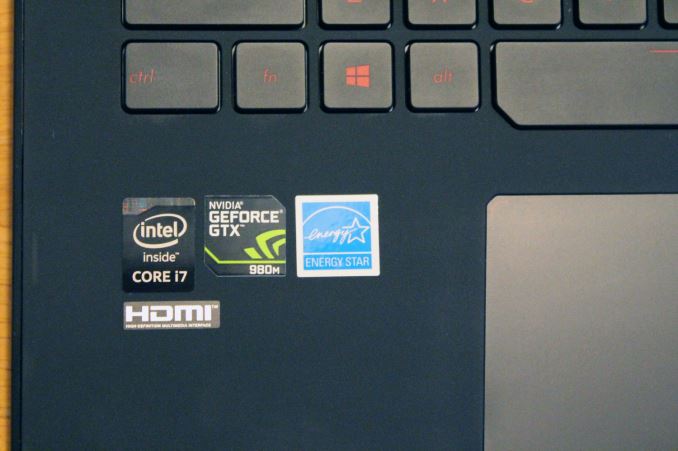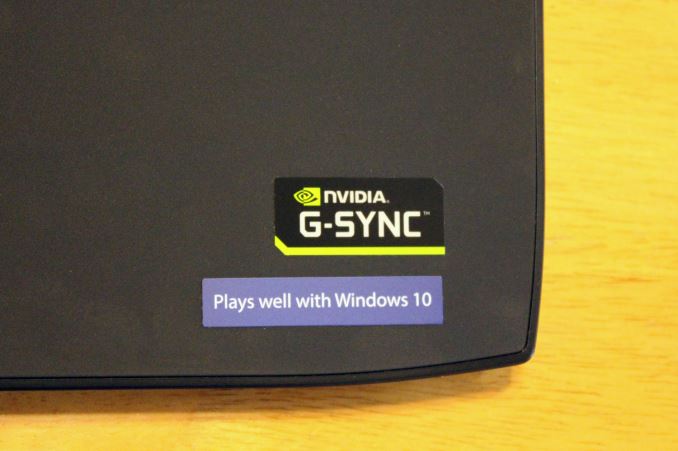The ASUS Republic of Gamers G751 Review: G-SYNC Comes To The Notebook Computer
by Brett Howse on July 29, 2015 8:30 AM EST
At Computex 2015, NVIDIA announced what will almost certainly be one of their marquee features on gaming notebooks going forward, with NVIDIA’S G-SYNC variable display refresh rate technology coming to notebooks. We’ll dive into this more in a bit, but perhaps the best part of the announcement was that it was going to be a hard launch, with several vendors offering notebooks featuring G-SYNC right away.
One of those was ASUS, and NVIDIA shipped me the ASUS G751JY model with G-SYNC to take a look at. The G751 was first introduced in October 2014. It is a 17.3-inch laptop targeted towards gamers under ASUS’s Republic of Gamers (ROG) branding. ASUS these days seems to have a focus on offering value, and by that I mean they often offer more computer for your money than most other brands. The ASUS Zenbook UX305 is a perfect example of this, offering excellent performance, specifications, and build materials for much less than the competition. Of the initial announcements of G-SYNC notebooks, ASUS has certainly come in with a lot of value here too.
The G751 has a couple of configuration options, with the G751JT model featuring the GTX 970M and G-SYNC, but this review is on the higher end G751JY model, which features the Intel Core i7-4720HQ processor, with four cores and eight threads available in a 47 Watt envelope. In order to have G-SYNC, you will need a NVIDIA GPU, and the JY model features NVIDIA's highest end mobile GPU, the GTX 980M, with 4 GB of memory onboard the graphics card. System memory is 24 GB on the model I received, with 3x8GB of DDR3L-1600, and a 256 GB SSD, which is the very fast Samsung XP941 PCIe model, and a 1 TB 7200 RPM drive for extra storage. Although optical media is certainly on the way out, with a 17.3-inch notebook there is plenty of room for an optical drive, and the G751JY features a 6x Blu-Ray writer.
| ASUS ROG G751JY | |||||
| As Tested, Core i7-4720HQ, 24 GB RAM, 256 GB SSD + 1TB HDD | |||||
| Processor | Intel Core i7-4720HQ (4C/8T, 2.6-3.6GHz, 6MB L3, 22nm, 47W) Intel Core i7-4870HQ (4C/8T, 2.5-3.7GHz, 6MB L3, 22nm, 47W) |
||||
| Memory | 24GB-32GB DDR3L-1600 MHz | ||||
| Graphics | NVIDIA GTX 980M 4GB | ||||
| Display | 17.3" 1920x1080 IPS Matte, 75Hz, G-SYNC | ||||
| Storage | 256GB-512GB Samsung XP941 PCIe SSD 1 TB 7200rpm HDD |
||||
| Networking | Intel Dual Band Wireless-AC 7260 Realtek 1 Gbps Ethernet |
||||
| Audio | Waves MAXX Audio Two speakers plus subwoofer |
||||
| Battery | 90 Wh Battery 230 Watt A/C Adapter |
||||
| Right Side | 2 x USB 3.0 Ports Headphone Jack Microphone Jack DisplayPort HDMI VGA SPDIF (3.5mm) |
||||
| Left Side | 2 x USB 3.0 Ports SD Card Reader Blu-Ray Burner |
||||
| Dimensions | 317.5 x 416.6 x 43.2mm (12.50 x 16.40 x 1.70 inches) | ||||
| Weight | 3.81 kg (8.4 lbs) | ||||
| Extras | 720p Webcam Backlit Keyboard |
||||
| Pricing | $2150 MSRP (i7-4720HQ, 24GB, 256GB SSD) Amazon.com $1900 $2650 MSRP (i7-4870HQ, 32GB, 512GBSSD) Amazon.com $2460 |
||||
A laptop that comes in at over $2000 may seem like a difficult thing to consider as a value play, but once again ASUS has really packed in a lot of performance for the price. For a bit more money, you can add in another 8 GB of memory and double the SSD capacity to 512 GB if you want to keep less of your data on the spinning disk. If you want G-SYNC with a GTX 980M, the ASUS offers a pretty good price to performance ratio.
At 8.4lbs, or 3.8 kg, this is no lightweight laptop, but there is certainly a market for people who want a desktop replacement-style laptop with lots of performance and a big display. The larger chassis is a bit more of a hassle to move around, but the extra display size makes for a very good gaming experience, and the larger chassis of a 17.3-inch notebook provides an opportunity for better system cooling with less noise. We’ll see how it measures up to the competition, with the MSI GT72 Dominator Pro likely being its direct competitor.












52 Comments
View All Comments
Meaker10 - Wednesday, July 29, 2015 - link
Indeed, the only way to get around this is to do what MSI have done and have a manual switch and on reboot move the traces over and run in IGP mode (without G-sync of course).Asus also only had the later G750 with optimus, before they actually avoided it generally in their 17 inch models. So really for asus the optimus models were a blip rather than a trend.
nerd1 - Friday, July 31, 2015 - link
Many laptops had hardware mux to switch GPU pre-optimus era (alienware had one) which is a way better solution than optimus.nightbringer57 - Wednesday, July 29, 2015 - link
As a matter of fact, everyone has been building some non optimus notebooks all the time.The Optimus technology requires the screen to be directly driven by the integrated GPU. Some custom technologies made by GPU manufacturers require the screen to be driven by the GPU himself. That's why the 3D laptops never sold, because Nvidia's 3D technology requires the screen to be driven by the nvidia GPU directly, so you can't have an Optimus-enabled 3D screen laptop (well, at least using nvidia 3D).
The same problem is true for G-Sync. So you can't technically have G-sync and optimus on the same laptop.
BMNify - Wednesday, July 29, 2015 - link
Exactly, the optimus tech even effects VR and you can't drive VR with igpu, many high end laptops are now coming without optimus due to customer demand.BMNify - Wednesday, July 29, 2015 - link
Optimus tech is reviled in the hardcore gaming community and gaming forums who pay $2000 plus for gaming laptops, many top-end gaming laptops have no optimus due to Customer demand !!Notmyusualid - Saturday, August 1, 2015 - link
^ This is true.Many don't buy a machine due to the very fact that Optimus is there.
However, I have a Dell M3800 HD4600/K1100M that has no issue with it.
boeush - Wednesday, July 29, 2015 - link
OK, bit why would anyone buy this now, when Skylake is right around the corner? Wait another couple of months, and an equivalent model with a better CPU and DDR4 is all but guaranteed by the holiday shopping season. Or, at the very least, this particular model will be selling at deep discounts by then...boeush - Wednesday, July 29, 2015 - link
Not to mention, a premium laptop this far into 2015, and with not a single USB 3.1 port? Tsk, tsk...meacupla - Wednesday, July 29, 2015 - link
because, you buy it when you need it, not when there is something new 'in a couple of months'.A week, sure, that's not a long wait, but 2 months to launch means you're going to be waiting another 6 months until the replacement for this type of gaming laptop to appear on the market.
boeush - Wednesday, July 29, 2015 - link
According to various leaks, Skylake H is launching in October. Skylake T (low voltage 35W i7 6700) is also launching about then or even sooner.Given that, why would anyone NOT expect all brands to refresh models with Skylake by Black Friday?? Any brand that fails to do that, is going to lose out huge this year.
So sure, retail availability of bixed CPUs is October, but I'll bet all the OEMs have had samples under NDA since spring, and are working to deliver updated models on the same day as the CPU launch.